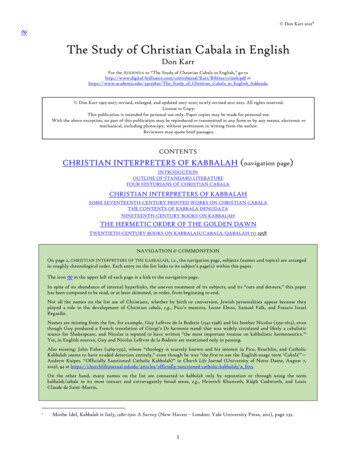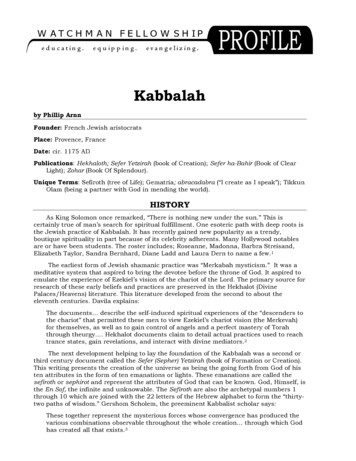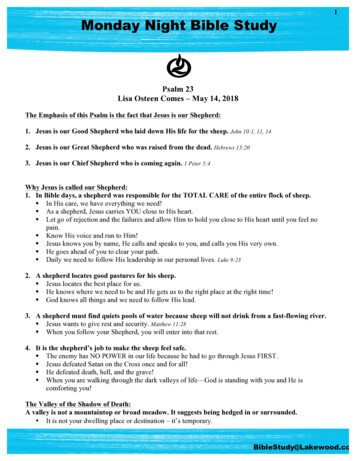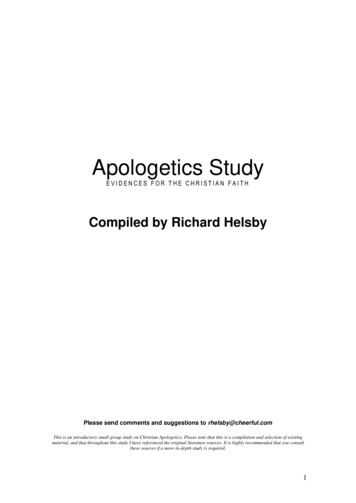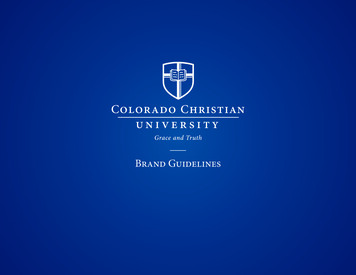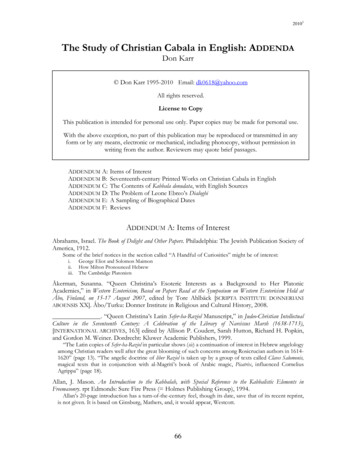
Transcription
20103The Study of Christian Cabala in English: ADDENDADon Karr Don Karr 1995-2010 Email: dk0618@yahoo.comAll rights reserved.License to CopyThis publication is intended for personal use only. Paper copies may be made for personal use.With the above exception, no part of this publication may be reproduced or transmitted in anyform or by any means, electronic or mechanical, including photocopy, without permission inwriting from the author. Reviewers may quote brief passages.ADDENDUM A: Items of InterestADDENDUM B: Seventeenth-century Printed Works on Christian Cabala in EnglishADDENDUM C: The Contents of Kabbala denudata, with English SourcesADDENDUM D: The Problem of Leone Ebreo’s DialoghiADDENDUM E: A Sampling of Biographical DatesADDENDUM F: ReviewsADDENDUM A: Items of InterestAbrahams, Israel. The Book of Delight and Other Papers. Philadelphia: The Jewish Publication Society ofAmerica, 1912.Some of the brief notices in the section called “A Handful of Curiosities” might be of interest:i.ii.iii.George Eliot and Solomon MaimonHow Milton Pronounced HebrewThe Cambridge PlatonistsÅkerman, Susanna. “Queen Christina’s Esoteric Interests as a Background to Her PlatonicAcademies,” in Western Esotericism, Based on Papers Read at the Symposium on Western Esotericism Held atǺbo, Finland, on 15-17 August 2007, edited by Tore Ahlbäck [SCRIPTA INSTITUTE DONNERIANIABOENSIS XX]. Ǻbo/Turku: Donner Institute in Religious and Cultural History, 2008. “Queen Christina’s Latin Sefer-ha-Raziel Manuscript,” in Judeo-Christian IntellectualCulture in the Seventeenth Century: A Celebration of the Library of Narcissus Marsh (1638-1713),[INTERNATIONAL ARCHIVES, 163] edited by Allison P. Coudert, Sarah Hutton, Richard H. Popkin,and Gordon M. Weiner. Dordrecht: Kluwer Academic Publishers, 1999.“The Latin copies of Sefer-ha-Raziel in particular shows (sic) a continuation of interest in Hebrew angelologyamong Christian readers well after the great blooming of such concerns among Rosicrucian authors in 16141620” (page 13). “The angelic doctrine of liber Raziel is taken up by a group of texts called Claves Salomonis,magical texts that in conjunction with al-Magriti’s book of Arabic magic, Picatrix, influenced CorneliusAgrippa” (page 18).Allan, J. Mason. An Introduction to the Kabbalah, with Special Reference to the Kabbalistic Elements inFreemasonry. rpt Edmonds: Sure Fire Press ( Holmes Publishing Group), 1994.Allan’s 20-page introduction has a turn-of-the-century feel, though its date, save that of its recent reprint,is not given. It is based on Ginsburg, Mathers, and, it would appear, Westcott.66
20103Allen, Paul M. (comp/ed). A Christian Rosenckreutz Anthology. Blauvelt: Rudolf Steiner Publications,1968 and 2000.This rich collection of writings and illustrations includes Ezechiel Foxcroft’s translation of The HermeticRomance, or the Chymical Wedding* (1690); Thomas Vaughan’s translations of Fama Fraternitatis and ConfesioFraternitatis (1652) and his Holy Mountain, A Rosicrucian Allegory; material from Heinrich Khunrath(Amphitheater of Eternal Wisdom, 1609), Robert Fludd (BOOK IV of Summun Bonum), Hinricus Madathanus(The Parabola, A Golden Tractate), Daniel Stolcius (Pleasure Garden of Chymistry); four articles by Rudolph Steiner;some bibliographic pieces; and The Secret Symbols of the Rosicrucians (1785).NOTE: There are two other noteworthy renditions of The Chymical Wedding: (i) Knight, Gareth. The Rose Cross and theGoddess: Quest for the Eternal Feminine Principle. New York: Destiny Books, 1985; in Part Three, pp. 89-111; and (ii) Godwin,Joscelyn (trans). The Chemical Wedding of Christian Rosenkreutz, introduction and commentary by Adam McLean [MAGNUMOPUS HERMETIC SOURCEWORKS #18], Grand Rapids: Phanes Press, 1991; this work calls itself “the first evercontemporary English translation.”Aptekman, Marina. THE LANGUAGE AND THE LIGHT, THE KABBALISTIC ALLEGORY IN RUSSIANLITERATURE: FROM RELIGIOUS PHILOSOPHY TO POLITICAL MYTHOLOGY. Ph.D. dissertation,Providence: Brown University, 2004.The first chapter, “Kabbalistic Philosophy: A Historical Perspective,” was hastily assembled from too fewsources. As for the rest, matters of Russian Masonry and mystical literature are beyond my abilities toappraise.The remaining three chapters analyze the place of kabbalistic allegory in Russian literature. The secondchapter discusses the role of the kabbalistic allegory in the Masonic literature of the second half of theeighteenth century. The third chapter discusses the mutation of kabbalistic imagery in early nineteenthcentury Romantic works, especially in the works by the authors who were interested in the idea of universalscience, such as Vladimir Odoevsky. The fourth chapter of the dissertation analyses the return ofkabbalistic symbolism in the literature of the Silver Age [as represented by Symbolist and Futurist writers]. The mystical interpretation of the images of Wisdom and Adam Kadmon dominates also in philosophicalworks of the Symbolist writers, especially in the works of Vladimir Soloviev. (PREFACE, pages 2-4) [mybrackets—DK]Refer to the English translation of Soloviev’s Transformation of Eros: An Odyssey from Platonic to Christian Eros,translated from the Russian by Richard Gill (St. Paul: Grailstone Press, 2004).See below, under “Burmistrov” and “Kornblatt,” both of whom Aptekman cites but omits from herbibliography. Also see “Faggionato” and “Leighton.”Bardon, Franz. The Key to the True Kabbalah [Volume III of THE HOLY MYSTERIES]. German original:Der Schlussel zur wahren Quabbalah, 1956; 1st English translation (by Gerhard Hanswille) Salt Lake City:Merkur Publishing, Inc., 1996.The Key to the True Kabbalah is the final book of a four-volume set which includes (i) the preamble, Frabatothe Magician (1979), a “mystical” novel which amounts to the author’s spiritual autobiography; (ii) Initiation intoHermetics (1956), a “course of magical instruction in ten steps”; (iii) The Practice of Magical Evocation (1956),instructions for evoking spirits, complete with seals. All of these titles were reprinted by Merkur.The Key to the True Kabbalah treats its subject as a “cosmic language” linked by sympathetic correspondenceto colors, elements, musical notes, and so on, as well as analogous influences in the akashic, mental, astral,and material realms. Guidelines for the magical use of one-, two-, three-, and four-letter keys (combinations)conclude the work.Baron, Salo Wittmayer. “Humanism and Renaissance” and “Protestant Reformation” chaptersLVII and LVIII of A Social and Religious History of the Jews: Late Middle Ages and Era of EuropeanExpansion (1200-1650): Volume XIII: INQUISITION, RENAISSANCE, AND REFORMATION, 2nd edition.New York – London: Columbia University Press/Philadelphia: The Jewish Publication Society, 1969.In § “Humanism and Renaissance,” see especially the sub-segments “Kabbalistic Bridges” and “ChristianKabbalism,” which give a quick history; and “Literary Battle Royal,” on Reuchlin’s involvement in variousaspects of the “Jewish question,” in particular his debate with Johannes Pfefferkorn which grew into aninternational controversy.67
20103Berg, Michael. The Secret History of the Zohar. Los Angeles: The Kabbalah Centre, 2008.Berg’s blend of fact and fable contains a chapter entitled “The Zohar’s Influence on the Renaissance, theAge of Discovery and Science” which discusses kabbalistic influence on Columbus (via Abraham Zucato),Michelangelo, Newton, and Edison, along with the more usual Christian Cabalists (Paracelsus, Dee, Pico,Reuchlin, von Rosenroth) and finally on to Ezra Stiles and Albert Pike.Bland, Kalman P. “Elijah del Medigo’s Averroist Response to the Kabbalah of Fifteenth-CenturyJewry and Pico della Mirandola,” in The Journal of Jewish Thought and Philosophy, vol. 1, edited by ElliotWolfson and Paul Mended-Flohr. Harwood Academic Publishers GmbH, 1991.Bland discusses del Medigo’s remarks on Kabbalah and its adherents found in four of his works, one ofwhich (his commentary to Averroes’ De substantia orbis) was originally composed in Latin for Pico’s benefit.Bloom, Harold. The American Religion: The Emergence of the Post-Christian Nation. New York: Simon andSchuster, 1992.Of particular interest is Bloom’s section on the Mormons: Chapter 5, “The Religion-Making Imaginationof Joseph Smith,” where Bloom states, “The God of Joseph Smith is a daring revival of the God of some ofthe Kabbalists and Gnostics, prophetic sages who, like Smith himself, asserted that they had returned to thetrue religion of Yahweh or Jehovah” (p. 99).Further on Joseph Smith and Kabbalah, see below under “Owens” and “Quinn.”. Omens of Millennium: The Gnosis of Angels, Dreams, and Resurrection. New York: RiverheadBooks, 1996.After putting the recent popularity of angels in its place in a section called “Their Current Debasement,”Bloom surveys some of the deeper and more abiding aspects of Western religious concern by showing theirroots, or likeness, in Gnosticism, Kabbalah, and Sufism. Bloom attempts to salvage at least a few shreds ofsublime speculation and spirituality from the kitsch of the new age.Bonfil, Robert. Jewish Life in Renaissance Italy [ Gle Ebrei in Italia nell’epoca del Rinascimento. Florence:Sansoni, 1991] translated by Anthony Oldcorn. Berkeley: University of California, 1994.Chapter V, “Jewish Culture, Hebraists, and the Role of the Kabbalah” (pp. 145-177), especially the lastthree sections: “The Diffusion of the Kabbalah” (pp. 169-72), “Christian Hebraists” (pp. 172-5), and “TheRole of the Kabbalah in the Evolution of Jewish Culture” (pp. 175-7).Burgeson, Sujan Jane. MYSTICAL SYMBOLISM IN TERESA OF AVILA AND CLASSICAL KABBALAH.Ph.D. dissertation, Berkeley: Graduate Theological Union, 1997.Teresa of Avila’s Interior Castle is analyzed against (i) the merkabah tradition, (ii) Abraham Abulafia’s“ecstatic” kabbalah, and (iii) the classical (theosophical) kabbalah of the Zohar and Gikatilla’s Sha’are Orah(Gates of Light).Refer to The Interior Castle by Teresa of Avila, translated by Mirabai Starr (New York: Riverhead Books,2003) and Entering Teresa of Avila’s INTERIOR CASTLE: A Reader’s Companion by Gilliam T. W. Ahlgren(Mahwah: Paulist Press, 2005)See below: “Deirdre Green.”Burmistrov, Konstantin. “Christian Orthodoxy and Jewish Kabbalah: Russian Mystics in Search forPerennial Wisdom,” in Polemical Encounters: Esoteric Discourse and Its Others, edited by Olav Hammerand Kocku von Stuckrad [ARIES BOOK SERIES: TEXTS AND STUDIES IN WESTERN MYSTICISM/6](Leiden – Boston: Brill, 2007).“We see that Russian Freemasons of the late eighteenth and early nineteenth centuries and theirintellectual successors—Russian philosophers and theologians who lived a century later—turned to kabbalahin order to solve problems which they felt were not adequately elaborated in Christian Orthodox theology.”(—page 50). “Kabbalah and Secret Societies in Russia (Eighteenth to TwentiethCenturies),” in Kabbalah and Modernity: Interpretations, Transformations, Adaptations, edited by Boaz Huss,Marco Pasi, and Kocku von Stuckrad [ARIES BOOK SERIES: TEXTS AND STUDIES IN WESTERNMYSTICISM/10] (Leiden – Boston: Brill, 2010).“There are two moments in the influence of kabbalistic ideas in Russia that are directly connected with thedevelopment of secret societies. After the establishment of the first Masonic lodges in the middle of the68
20103eighteenth century, Russians became acquainted with various ideas as works related to kabbalah. The impactof these ideas especially intensified with the advent of Rosicrucian lodges in the 1780s. The first period wasinterrupted witht the official prohibition of freemasonry in Russia in the 1820s, but some backgroundMasonic activity continued until the 1850s-1860s. The second period, between the 1880s and the 1930s, ischaracterized by an increased interest in the occult sciences, which culminates in the 1910s-1920s. In the1930s, most of the members of various secret societies and occult groups were arrested and executed by thecommunist regime.” (—page 79)Burmistrov, Konstantin; and Endel, Maria. “Kabbalah in Russian Masonry: Some PreliminaryObservations,” in Kabbalah: Journal for the Study of Jewish Mystical Texts, Volume Four, edited by DanielAbrams and Avraham Elqayam. Los Angeles (Culver City): Cherub Press, 1999.“We will argue that the Russian Masons were deeply interested in kabbalistic matters. We will review thebasic kinds of Masonic manuscript texts related to the Kabbalah and some kabbalistic concepts which areimportant to the Russian Masons. Finally, we will offer some preliminary reasons for this interest among theRussian Mason” (from the article, p. 11). It was the Christian Cabala, already subsumed into EuropeanMasonry, upon which these Russian Masons drew.Konstantin Burmistrov and Maria Endel were regular contributors to the now defunct Russian-languagejournal, TIROSH: STUDIES IN JUDAICA, which survived through eight or nine volumes (Moscow: 1998-2007). “The Place of Kabbalah in the Doctrine of Russian Freemasons,” in Aries: Journal forthe Study of Western Esotericism, VOLUME 4, NUMBER 1 (Leiden: Brill Academic Publishers, 2004).“Two Principle trends may be identified in Russian freemasonry of the late 18th-early 19th centuries:rationalistic (deistic) and mystical” (p. 29). “The Order [of the Gold- and Rosy Cross] was founded byBernhard Joseph Schleiss won Loewenfeld (1731-1800) [who] took an obvious interest in Kabbalah as iffollowing the traditions of the Sulzbach Christian Kabbalah [i.e., von Rosenroth and van Helmont] of thelate seventeenth century” (p. 31 [my brackets—DK]).Burnham, Jack. Great Western Salt Works: Essays on the Meaning of Post-Formalist Art. New York: GeorgeBraziller, 1974.Essays include “Duchamp’s Bride Stripped Bare: The Meaning of the ‘Large Glass,’” which discussesDuchamp’s work in relation to Tarot images and the kabbalistic tree of life, and “Voices from the Gate,” whichrelates the Cabala to an installation by Robert Morris entitled Hearing.Busi, Giulio. Mantua e la qabbalah / Mantua and the Kabbalah. Milano: Skira editore, 2001. [Cataloguefor the exhibition of Mantuan kabbalistic manuscripts, Mantova: Palazzo della Ragione (September2001), and New York: Casa Italiana Zerilli-Marimò Center for Jewish History (March 2002)].Articles in Italian and English. See in particular “The Mantuan Kabbalistic Workshop,” § 1. THE HEBREWLANGUAGE AND THE MYTH OF THE RENAISSANCE: CRYPTOGRAPHY IN THE STUDIOLO OF ISABELLA D’ESTE,and § 2. THE HUMANISTIC KABBALAH OF YOCHANAN ALEMANNO.Case, Paul Foster. The True and Invisible Rosicrucian Order. An Interpretation of the Rosicrucian Allegory andan Explanation of the Ten Rosicrucian Grades. 1953; rpt. York Beach: Samuel Weiser, 1985 andsubsequently.In the manner of the Golden Dawn, Case connects the Rosicrucian grades with the sefirot of the kabbalistictree of life and groupings of tarot cards. Case’s distillations of Western occult doctrine serve as the coreteachings of an order which is still active: The Builders of the Adytum (BOTA) of Los Angeles. The Book of Tokens: Tarot Meditations. 22 Meditations on the Ageless Wisdom. 1934; (10thedition) Los Angeles: Builders of the Adytum, 1983.“These unusual and beautiful Qabalistic meditations were inspirationally written by the recognized worldauthority in Tarot and Qabalah, Dr. Paul Foster Case.” (from the PREFACE)Cavendish, Richard. The Black Arts. New York: G. P. Putnam’s Sons, 1967.Chapter III, “The Cabala and the Names of Power,” offers a pretty fair introduction to Western occultqabalah.69
20103Colquhoun, Ithell. The Magical Writings of Ithell Colquhoun, edited by Steve Nichols. Self-published; 2007 by Ithell Colquhoun and Steve Nichols. Available from LULU, on-line at http://www.lulu.com/The first four chapters of this collection are illustrated expositions on Golden Dawn-style qabalah, underthe general heading “The Crown and the Kingdom”: 1) “History of the QBL,” 2) “The Ten Sephiroth,” 3)“The Twenty-Two Paths,” and 4) “The Four Hundred Desirable Worlds.” A victim of the pseudoscholarship which preceded her, Colquhoun (1906-1988) offers in these essays a remarkably highconcentration of distortions and mistakes characteristic of Western esoteric qabalah.Copenhaver, Brian P. “Lefevre d’Etaples, Symphorien Champier, and the Secret Names of God,” inJournal of the Warburg and Courtauld Institutes, Volume Forty (London: The Warburg Institute –University of London, 1977).“Here my intention is simply to shed light on the significance and depth of the work [i.e., Lefevre’s Demagica naturali] by studying Lefevre’s development of one Cabalist theme—the secret names of God—in thefinal chapters of book two of De magica naturali” (p. 119). Copenhaver asserts that De magica naturali (1492-94)was the first description of Cabala in Renaissance France as a correction to François Secret’s contention thatSymphorien Champier’s Ars parva Galeni (1516) was “la premiere presentation de la kabbale par un François”(in Les Kabbalistes Chretiens de la Renaissance [Paris: Dunod, 1964] p. 152). “Scholastic Philosophy and Renaissance Magic in the De Vita of Marsilio Ficino,” inRenaissance Quarterly, vol. 37 (The Renaissance Society of America, 1984); and Articles on Witchcraft,Magic and Demonology, Volume 11: RENAISSANCE MAGIC, edited by Brian Levack (New York –London: Garland Publishing, Inc., 1992).“Since the Enlightenment, the occultist tradition has lost almost all cognitive authority among educatedpersons in the West, so much so that in our time an intellectual who seriously professed belief in magicwould thereby call into question his own seriousness. One of the reasons why magical beliefs have becomeliterally incredible is that we have discarded their philosophical foundations, but in Ficino’s day thefoundations were intact—indeed, Ficino and others were still extending them.” (RQ p. 524/AWMD p. 52).Couliano, Ioan P. [ Ioan Petru Culianu] Eros and Magic in the Renaissance. [ Eros et Magie a laRenaissance, 1484. Paris: 1984] Chicago: University of Chicago Press, 1987.Couliano approaches magic as (quoting his introduction) “a science of the imaginary” which was believedto be capable of exerting “control over the individual and the masses based on deep knowledge of personaland collective erotic impulses”; thus, “[w]e can observe in it not only the distant ancestor of psychoanalysisbut also, first and foremost, that of applied psychosociology and mass psychology.” Couliano discussesFicino, Pico, and Bruno.Culianu, Ioan Petru. “Magic in Medieval and Renaissance Europe,” in Hidden Truths: Magic, Alchemy,and the Occult, edited by Lawrence E. Sullivan. [RELIGION, HISTORY, AND CULTURE: Selections fromThe Encyclopedia of Religion, Mircea Eliade—editor in chief]. New York: Macmillan Publishing andLondon: Collier Macmillan, 1989.See below under “Thorndike” where the rather harsh opening paragraph of Culianu’s article is quoted.Dan, Joseph. “Medieval Jewish Influences on Renaissance Concepts of Harmoria Mundi,” in Aries:Journal for the Study of Western Esotericism, vol. 1, no. 2 (Leiden: Brill, 2001).Dan traces scientific and mystical ideas starting with the Sefer Yezirah, elaborations of tenth-centurycommentaries on it, especially that of Shabbatai Donnolo, and developments of the Hasidei Ashkenaz, inparticular Eleazar of Worms. Dan shows how these commentaries “contributed to the establishement of theconcept of harmonia mundi as a dominant world-view in Europe in the sixteenth and seventeenth centuries,mainly in the context of the variegated phenomena which are sometimes united under the general title‘Christian kabbalah.’”De Givry, Grillot. Picture Museum of Sorcery, Magic, and Alchemy [original French: Le Musee des sorciers,mages et alchimistes. Paris: 1929], translated by J. Courtney Locke. Boston: Houghton, 1931; rpt. NewHyde Park: University Books Inc., 1963; rpt. as Witchcraft, Magic and Alchemy, New York: Dover, 1971.Picture Museum has been described as a “coffee-table book” of the Medieval and Renaissance occult,which gives the false impression that it is a trivial work. It just happens to contain a lot of illustrations.70
20103Decker, Ronald; Depaulis, Thierry; and Dummett, Michael. A Wicked Pack of Cards: The Origins of theOccult Tarot. New York: St. Martin’s Press, 1996.A Wicked Pack of Cards discusses how Tarot came to be positioned at the core of the Western esoterictradition, focusing on its assumption by the French occultists J.-B. Alliette ( Etteilla), Eliphas Levi, GerardEncausse ( Papus), and Paul Christian.Decker, Ronald; and Dummett, Michael. The History of the Occult Tarot: 1870-1970. London:Duckworth, 2002.History picks up where Wicked Pack leaves off: tracing the developments of tarot down through thedescendents of the Golden Dawn, i.e., A. E. Waite, Aleister Crowley, Dion Fortune, C. C. Zain, Paul FosterCase, etc.Denning, Melita; and Phillips, Osborne. The Magical Philosophy. [5 vols.] St. Paul: LlewellynPublications, 1974-1981. Volume III: THE SWORD AND THE SERPENT—COSMO DYNAMICS(QABALAH AND MAGICAL ART).The five-volume set represents the complete teachings of The Order of the Sacred Word, also calledAurum Solis, a descendant of the Golden Dawn.Duncan, A. D. The Christ, Psychotherapy and Magic: A Christian Appreciation of Occultism. London: GeorgeAllen and Unwin Ltd, 1969.“We shall be concerned with the Qabalah as Gentile occultists have received it from the traditions ofJudaism,” states the preface. Duncan’s primary sources are Dion Fortune’s writings and Gareth Knight’sPractical Guide to Qabalistic Symbolism.Eco, Umberto. Foucault’s Pendulum. San Diego: Harcourt Brace Jovanovich, Inc., 1989.Eco’s snide novel follows three Milanese editors as they concoct, then investigate, then get caught up in agrand esoteric conspiracy involving a twisted amalgam of secret societies and mystical traditions. In thisentertaining but ultimately anticlimactic tale, Eco’s well-studied ease with source works of the HermeticCabalist tradition is strutted about. The Search for the Perfect Language. Oxford and Cambridge: Blackwell Publishers Ltd,1995.Chapters include [2] “The Kabbalistic Pansemioticism” and [6] “Kabbalism and Lullism in ModernCulture,” which includes a section on Bruno. Kircher is given quite a bit of attention in CHAPTER 7, “ThePerfect Language of Images,” and Dee is discussed in CHAPTER 8, “Magic Language.”. Serendipities: Language and Lunacy. [ITALIAN ACADEMY LECTURES, THE ITALIANACADEMY] translated by William Weaver. New York: Columbia University Press, 1998.This collection of essays is, in part, an extension of Eco’s Search for the Perfect Language, especially Chapter 2,“Languages in Paradise.” There is a substantial section on Athanasius Kircher in the third essay, “FromMarco Polo to Leibniz: Stories of Intellectual Misunderstandings.”Edlow, Rachel B. “BOTTE FOR I AM A WOMAN”: JULIAN OF NORWICH, MEDIEVAL JEWISHMYSTICISM, AND THE EVOLUTION OF THE DIVINE FEMININE. MA Thesis; Washington: AmericanUniversity, 2005.“A distinct textual link between Moses de Leon’s thirteenth-century Zohar and the fourteenth-centuryShewings of Julian of Norwich suggests Julian’s role in appropriating the ideas of her surrounding cultures intoher mystical writings. Building on both the principle of the Divine Feminine and the allegorical nature ofparts of the Zohar, Julian constructs a notion of God as Mother that combats the misogyny of medievalChristian doctrine and secures her place as a woman writer in a male-dominated Church, defending a role asvisionary and writer for herself and for her female successors.” (—from the ABSTRACT)Ennomoser, Joseph. The History of Magic, 2 volumes, translated from the German by William Howitt.German original, Munich: 1843; first English translation, London: 1854; rpt New Hyde Park:University Books, 1970.Ennomoser discusses “Cabbalah,” in VOLUME 1, PART 1, especially pp. 7-21, as derived from FranzJoseph Molitor’s Philosophie der Geschichte oder ueber die Tradition (4 volumes, Muenster: Theissing, 1827-57). See71
20103The History of Magic, VOLUME 2, THIRD DIVISION, for accounts of Paracelsus, Baptista van Helmont, Agrippa,Fludd, Kircher, Cagliostro, Swedenborg, and Böhme, among others.Epstein, Perle. The Private Labyrinth of Malcolm Lowry: UNDER THE VOLCANO and the Cabbala. NewYork – Chicago – San Francisco: Holt, Rinehart and Winston, 1969.Private Labyrinth is the first “scholarly” book which I saw (in the early ’seventies) which drew a distinctionbetween “The Two Cabbalahs,” namely Jewish and Christian—including the late occult “qabalah” of theGolden Dawn—without dismissing the latter out-of-hand, which, until very recently, academics tended todo. Recall Scholem’s comments in Kabbalah, p. 203: “To this category of supreme charlatanism belong themany and widely read books of Eliphas Levi, Papus , and Frater Perdurabo , all of whom had aninfinitesimal knowledge of Kabbalah that did not prevent them from drawing freely on their imaginationsinstead”; or in Major Trends in Jewish Mysticism, pp. 2 and 353: “From the brilliant misunderstandings ofAlphonse Louis Constant, who won fame under the pseudonym of Eliphas Levi, to the highly colouredhumbug of Aleister Crowley and his followers, the most eccentric and fantastic statements have beenproduced purporting to be legitimate interpretations of Kabbalism No words need be wasted on thesubject of Crowley’s ‘Kabbalistic’ writings in his books on what he was pleased to term ‘Magick,’ and in hisjournal, The Equinox.”Lowry’s letters suggest that Frater Achad was a particular favorite of his. In Epstein’s bibliography,however, some of the works listed as having been authored by Achad were written by others. Achad indeedwrote The Anatomy of the Body of God and QBL, but he was not, as Epstein has it, the editor of The Equinox orthe author of Sepher Sephiroth (in The Equinox, Volume 1, Number 8); these were Crowley’s works. Nor didAchad write “A Note on Genesis” (in The Equinox, Volume 1, Number 2); this belongs to Allan Bennett. (Allof these works are given notice in the present paper: PART 2.)Faggionato, Raffaella. A Rosicrucian Utopia in Eighteenth-Century Russia: The Masonic Circle of N. I.Novikov [INTERNATIONAL ARCHIVES, 190]. Dordrecht: Springer, 2005.“Drawing a comprehensive and convincing picture of Russia’s assimilation of contemporary Westernintellectual values and traditions, Professor Faggionato offers some telling overall conclusions: the process ofEuropeanisation, forcefully initiated by Peter the Great, coming on top of the church crisis of the eighteenthcentury, resulted in an intellectual disorientation of the elites that threatened both the social and politicalsystem. Masonic lodges and mystically oriented circles of the nobility sought ways to reform and stability byblending traditional Christian spirituality with scientific insight into the workings of Nature. RosicrucianHermeticism and esoterism were ready to offer them guidance on this path.”—Marc Raeff in the PREFACE to A Rosicrucian Utopia Faivre, Antoine. Access to Western Esotericism [SUNY SERIES IN WESTERN ESOTERIC TRADITIONS].Albany: State University of New York Press, 1994.“Book One” and “A Bibliographical Guide to Research” in Access constitute something of a studymanual for Western Esotericism. “Book Two” presents a series of essays concerned with Franz von Baader(the nineteenth-century Christian “gnostic”), Masonic and Rosicrucian doctrine, and gnosis—old and new.Themes outlined in Access are followed up in Faivre’s Theosophy, Imagination, Tradition: Studies in WesternEsotericism [SUNY SERIES IN WESTERN ESOTERIC TRADITIONS] Albany: State University of New York Press,2000.Note also Faivre’s article, “The Notions of Concealment and Secrecy in Modern Esoteric Currents sincethe Renaissance (A Methodological Approach),” in Rending the Veil: Concealment and Secrecy in the History ofReligions, edited by Elliot R. Wolfson (New York – London: Seven Bridges Press, 1999).Fanger, Claire. “Mirror, Mask and Anti-self: Forces of Literary Creation in Dion Fortune and W. B.Yeats,” in Esotericism, Art, and Imagination, edited by Arthur Versluis, Lee Irwin, John Richards, andMelinda Weinstein (East Lansing: Michigan State University, 2008).“A part of my concern will be to show how the functions and processes of creative activity documentedby these authors may be mapped onto a set of essentially Freudian ideas, particularly those surroundingnarcissism.” —page 161Forshaw, Peter J. “Oratorium—Auditorium—Laboratorium: Early Modern Improvisations on Cabala,Music, and Alchemy, in Aries: Journal for the Study of Western Esotericism, VOLUME 10, NUMBER 2 (Leiden: BrillAcademic Publishers, 2010).72
20103Gnosis. A Journal in Western Inner Traditions, Number 3 - KABBALAH: EXPLORING THE ROOTS OFMYSTICISM. San Francisco: The Lumen Foundation, Fall/Winter 1986-7.Stock pop-Kabbalah stuff here: the overview, the Kabbalah-and-psychology piece, the interview withZalman Schachter, the recommended-reading piece (this one is particularly poor), etc., though surprisinglysticking pretty much with Jewish Kabbalah. Pinchas Giller’s overview, though brief, is nicely done; hediscusses the tension between Kabbalah and Maimonidean rationalism. Giller’s piece is, however, plagued bysome distracting typos (e.g. “the brown of the skull” for “the crown of the skull” in an account of the Zohar’santhropomorphic descriptions of God—page 12). Perhaps the most interesting article in the issue is JayKinney’s “A Higher Geometry: The Unique Kabbalistic Research of the Meru Foundation.” (Back issues ofGnosis are available at www.lumen.org.)Godwin, David. Godwin’s Cabalistic Encyclopedia: A Complete Guide to Cabalistic Magick. 2nd edition: St,Paul: Llewellyn Publications, 1989.Dictionary would be more accurate. Hebrew and other words and names are listed alphabetically (viaEnglish and Hebrew in two separate sections) and by num
Burmistrov, Konstantin. "Christian Orthodoxy and Jewish Kabbalah: Russian Mystics in Search for Perennial Wisdom," in Polemical Encounters: Esoteric Discourse and Its Others, edited by Olav Hammer and Kocku von Stuckrad [ARIES BOOK SERIES: TEXTS AND STUDIES IN WESTERN MYSTICISM/6] (Leiden - Boston: Brill, 2007).

